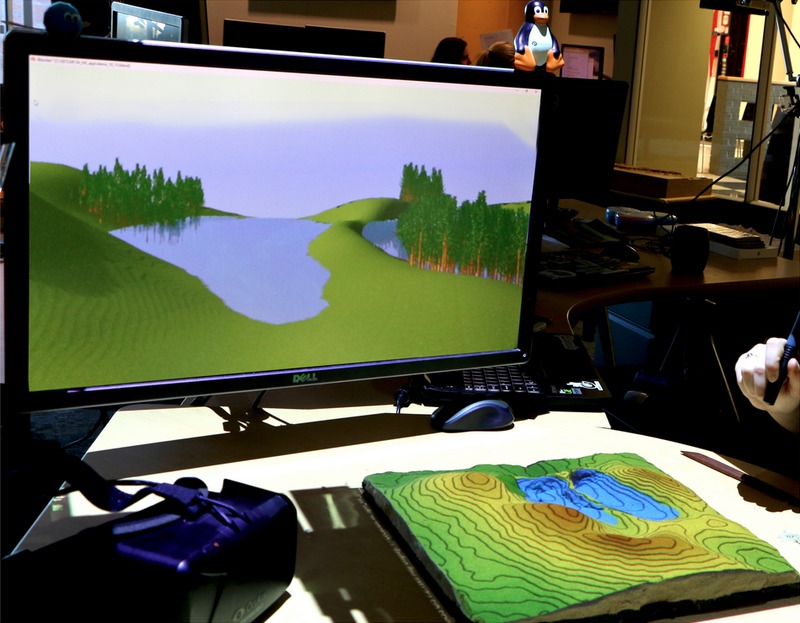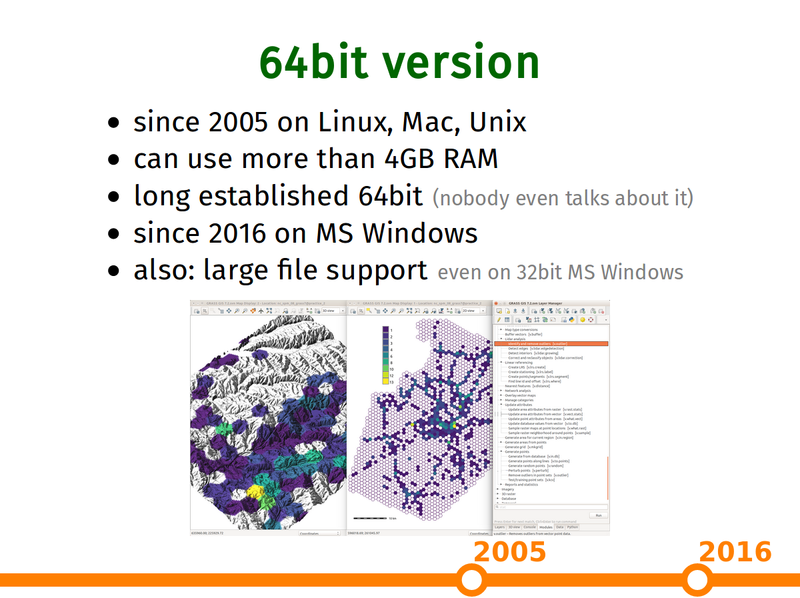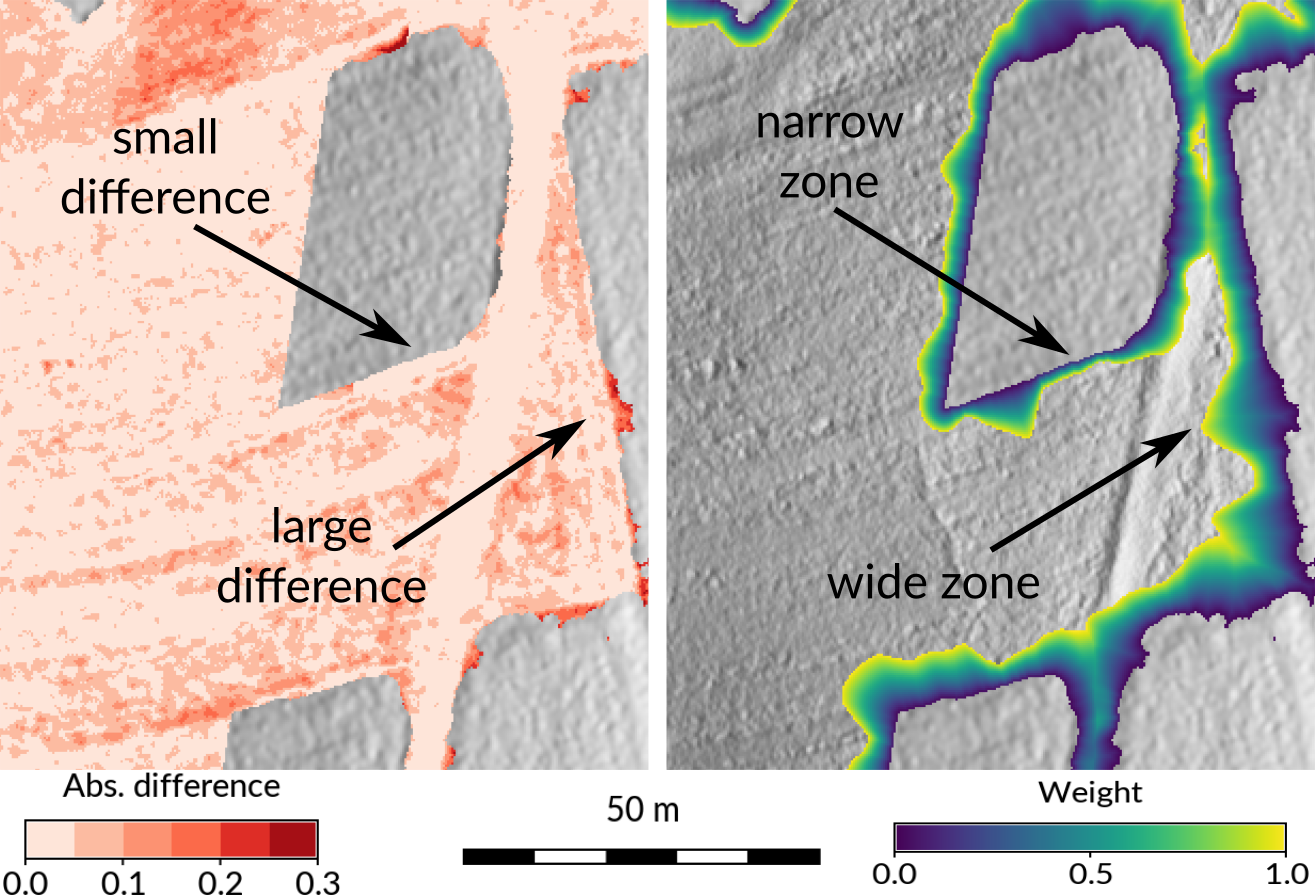GRASS GIS at NCGIS2017: Difference between revisions
Jump to navigation
Jump to search
⚠️Wenzeslaus (talk | contribs) |
⚠️Wenzeslaus (talk | contribs) (→Posters: add How innovations thrive in GRASS GIS) |
||
| Line 34: | Line 34: | ||
== Posters == | == Posters == | ||
=== How innovations thrive in GRASS GIS === | |||
[[File:How innovations thrive in GRASS GIS.png|300px|thumb|right|''How innovations thrive in GRASS GIS'']] | |||
by Vaclav Petras (presenter, typesetter), Yann Chemin, Martin Landa, Thomas Leppelt, Pietro Zambelli, Luca Delucchi, Margherita Di Leo, Sören Gebbert, and Markus Neteler | |||
* Citation: Vaclav Petras, Yann Chemin, Martin Landa, Thomas Leppelt, Pietro Zambelli, Luca Delucchi, Margherita Di Leo, Sören Gebbert, and Markus Neteler (2017). ''How innovations thrive in GRASS GIS''. Poster at NCGIS2017 Raleigh, NC, USA, Feb. 22-24, 2017 | |||
* Highlights: Algorithms and models included in GRASS GIS remain available long term. Analytical tools are not limited to one domain but spread across many fields. New tools can be built based on functionality or code of the existing ones regardless of the particular domain of problems they belong to. Both the functionality and the code are evaluated by the community of users and developers in different fields and scales. | |||
* Outline: Lidar Data Processing, Water, Floods and Erosion, Image Segmentations, Topology, Cleaning, Overlays, Attributes, Spatio-Temporal Data Analysis, Vector Network Analysis, Landscape Structure | |||
* PDF download: https://trac.osgeo.org/grass/export/70673/grass-promo/grassposter/2017_NCGIS_How_innovations_thrive/How_innovations_thrive_in_GRASS_GIS.pdf | |||
Revision as of 01:37, 26 February 2017
North Carolina GIS Conference, NCGIS2017, Feb. 22-24, 2017, Raleigh, NC, http://ncgisconference.com/
Presentations
Immersive Tangible Landscape

by Payam Tabrizian (presenter), Anna Petrasova (presenter), Brendan Harmon, Vaclav Petras, and Helena Mitasova from NCSU
- Citation: Payam Tabrizian (presenter), Anna Petrasova (presenter), Brendan Harmon, Vaclav Petras, and Helena Mitasova (2017). Immersive Tangible Landscape. Presentation in Technology - Spatial Analysis and Big Data 2 session at NCGIS2017 Raleigh, NC, USA, Feb. 22-24, 2017
- Description: Tangible Landscape is a tangible interface for geographic information systems (GIS). It interactively couples physical and digital models of a landscape so that users can intuitively explore, model, and analyze geospatial data in a collaborative environment. Conceptually Tangible Landscape lets users hold a GIS in their hands so that they can feel the shape of the topography, naturally sculpt new landforms, and interact with simulations like water flow. Since it only affords a bird's-eye view of the landscape, we coupled it with an immersive virtual environment so that users can virtually walk around the modeled landscape and visualize it at a human-scale. Now as users shape topography, draw trees, define viewpoints, or route a walkthrough, they can see the results on the projection-augmented model, rendered on a display, or rendered on a head-mounted display. In this paper we present the Tangible Landscape Immersive Extension, describe its physical setup and software architecture, and demonstrate its features with a case study.
- Slides: https://ncsu-geoforall-lab.github.io/tangible-landscape-talk/ncgis2017
33 years of GRASS GIS as an innovation platform

by Vaclav Petras from NCSU
- Citation: Vaclav Petras (2017). 33 years of GRASS GIS as an innovation platform. Presentation in Technology - UAS & Remote Sensing 2 session at NCGIS2017 Raleigh, NC, USA, Feb. 22-24, 2017
- Description: US Army CERL started GRASS GIS development in early 80s. Since then, researches around the world have been selecting GRASS GIS as a platform for their new tools. Early on GRASS GIS got 3D view, advanced interpolation methods, hydrology and image processing tools. 3D rasters and time series are now standard data types at the same level as vectors or rasters. Recent developments include novel landform detection, tangible user interface and spatio-temporal algebra. This talk will cover all of this and will show why you should start using GRASS GIS today.
- Slides: https://ncsu-geoforall-lab.github.io/grass-as-a-platform/ncgis2017.html
Seamless fusion of high-resolution DEMs from multiple sources

by Anna Petrasova (presenter), Helena Mitasova, Vaclav Petras, and Justyna Jeziorska from NCSU
- Citation: Anna Petrasova, Helena Mitasova, Vaclav Petras, and Justyna Jeziorska (2017). Seamless fusion of high-resolution DEMs from multiple sources. Presentation in Technology - UAS & Remote Sensing 2 session at NCGIS2017 Raleigh, NC, USA, Feb. 22-24, 2017
- Description: With the increased availability of UAS technologies we can produce extremely high resolution 3D data as often as we need for monitoring of crops, landscape processes, or natural hazards. For certain applications the limited extent of UAS-based data requires us to merge the high resolution topography with other data sources such as lidar. However, simple patching creates discontinuities or artificial edges in the merged DEMs leading to artifacts in modeling results and visualization. In this presentation I will show how to derive seamless digital elevation models combining different sources including time-series of UAS, lidar, and Kinect data, and I will explain how this simple, yet powerful method can be implemented in GIS.
- Slides: https://petrasovaa.github.io/dem-fusion-talk
Posters
How innovations thrive in GRASS GIS

by Vaclav Petras (presenter, typesetter), Yann Chemin, Martin Landa, Thomas Leppelt, Pietro Zambelli, Luca Delucchi, Margherita Di Leo, Sören Gebbert, and Markus Neteler
- Citation: Vaclav Petras, Yann Chemin, Martin Landa, Thomas Leppelt, Pietro Zambelli, Luca Delucchi, Margherita Di Leo, Sören Gebbert, and Markus Neteler (2017). How innovations thrive in GRASS GIS. Poster at NCGIS2017 Raleigh, NC, USA, Feb. 22-24, 2017
- Highlights: Algorithms and models included in GRASS GIS remain available long term. Analytical tools are not limited to one domain but spread across many fields. New tools can be built based on functionality or code of the existing ones regardless of the particular domain of problems they belong to. Both the functionality and the code are evaluated by the community of users and developers in different fields and scales.
- Outline: Lidar Data Processing, Water, Floods and Erosion, Image Segmentations, Topology, Cleaning, Overlays, Attributes, Spatio-Temporal Data Analysis, Vector Network Analysis, Landscape Structure
- PDF download: https://trac.osgeo.org/grass/export/70673/grass-promo/grassposter/2017_NCGIS_How_innovations_thrive/How_innovations_thrive_in_GRASS_GIS.pdf